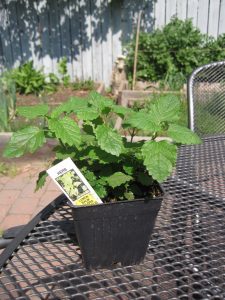Lemon balm (Melissa officianalis) is an old world plant that has become naturalized around the world due to its medicinal reputation.
I don’t know of any culinary use except as a tisane. So when I saw this plant at the local nursery in the spring, I thought why not see how it will thrive in the house this winter? Besides, I liked its looks.

For advice on growing lemon balm, I opened the “Herbs” volume of my Time Life Encyclopedia of Gardening (1977). I also poked around on the Internet. This is what I found:
- Lemon balm is hardy perennial from Zones 4 to 9.
- Soil needs to be light, dry, relatively poor, according to Time Life, or rich, moist, and well drained, according to Internet sources.
- Light should be full sun or part shade.
- If it bolts (goes to seed), the flavours in the leaves will not be as intense.
- Watering seems to be controversial. One Internet article says do not let the soil dry out between waterings. Yet two paragraphs later, it says the plant is drought tolerant and useful in xeriscaping. Time Life is silent on the subject.
- One Internet source says that if it’s brought indoors, don’t expect it to last more than a season because it will get leggy. However Time Life says go ahead and bring it indoors, but prune it periodically to keep it bushy at six to eight inches high.
- Lemon balm is susceptible to whitefly, spider mites, thrips, and powdery mildew.
So I put my nursery plant into a clay pot with ordinary potting soil. It’s been outside all summer on my southwest facing deck. Our weather has been a lot of hot summer days and frequent, almost daily rain. When it didn’t rain for a few days the plant suddenly withered over the course of hours. But after I watered it, it perked up quickly. The first time it wilted, it was so bad that some leaves completed dried out and never recovered.
Now we’re at the end of summer and it hasn’t bolted. As an outdoor plant, it is very leafy and smells lovely when you brush by it.
Only in the last month have I started using the plant. I pinch off a half a shoot or two, swish it in warm water to remove the bugs and dust, and stuff it in a teapot. I add boiling water and let it steep. It is a mild drink but it’s refreshing. I think I would have to pack the teapot with shoots to get the intense flavour that I would expect from a commercial tisane.
When I bring my lemon balm into the house in the fall, I’ll spray down the whole plant, especially under the leaves, with soapy water to knock off any insects.
The folklore of lemon balm

It spreads rapidly from seed. Some areas regard it an invasive because it seeds so readily.
The ancients, such as Pliny the Elder, recommended a decoction of lemon balm leaves as a cure for scorpion and dog bites.
In Charlemagne’s time it was used to promote youth. These days, it is promoted as a mild sedative and “curing.”
Lemon balm’s cures
Melissa officinalis has been investigated for several properties, including antiviral, anti-fungal, anti-oxidant , anti-inflammatory, and sedative.
It’s been investigated as “might be suitable” against herpes.